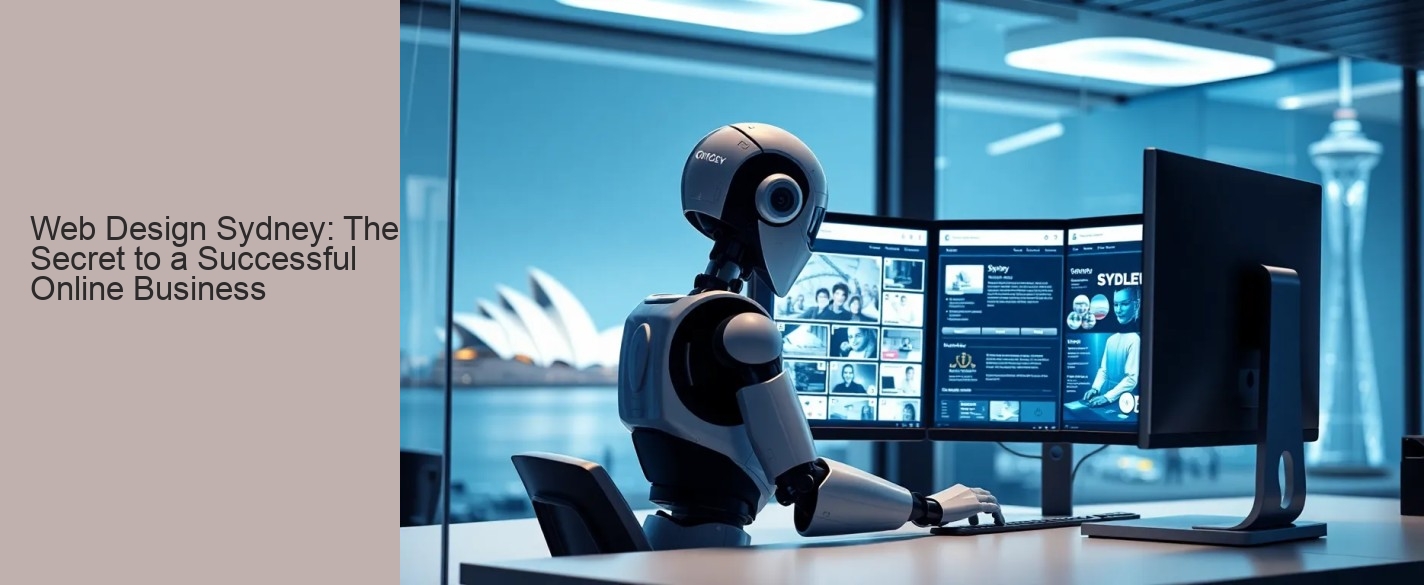Understanding the Basics of Web Design
Grasping the Fundamentals
Web design is a multidisciplinary, creative process that involves planning, conceptualizing, and arranging content intended for the Internet. Web Design Sydney: A Must-Have for Your Digital Marketing Strategy . It stretches beyond just aesthetics to encompass website functionality and user experience. The basics of web design include understanding HTML (HyperText Markup Language), CSS (Cascading Style Sheets), and JavaScript - these are the building blocks that create the structure, style, and interactive elements of a website. Furthermore, web designers must also consider site navigation, responsiveness to different devices (mobile vs desktop), color theory application, typography choice, multimedia incorporation and most importantly - usability for site visitors. These fundamentals serve as a starting point for any aspiring web designer in crafting effective digital experiences.
Importance of Web Design in Digital Marketing
Creating an Effective First Impression
Web design plays a vital role in digital marketing as it's often the first point of interaction between a brand and its potential customers. An aesthetically pleasing, easy-to-navigate website can make a lasting positive impression, encouraging visitors to explore further. On the contrary, a poorly designed website can deter potential customers, regardless of how good the products or services are. This is why investing in professional web design is essential; it can significantly enhance user experience and engagement levels, leading to higher conversion rates.
Optimizing for Search Engines
Beyond aesthetics, effective web design also includes optimizing for search engines. SEO-friendly web design helps increase visibility on search engine results pages (SERPs), resulting in more organic traffic and potential leads. It includes aspects like faster page load speeds, mobile compatibility, and proper use of keywords throughout site content. In the competitive digital marketplace where businesses vie for consumer attention, having an SEO-optimized website can give a significant advantage in reaching target audiences more effectively.
Elements of an Effective Website Design
Crucial Components for Successful Web Design
An effective website design is a blend of aesthetics and functionality. A visually pleasing layout paired with smooth navigation significantly enhances user experience. The use of appropriate color schemes, fonts, and graphics sets the mood, reflects brand identity and aids in information delivery. Moreover, a well-structured layout helps users find what they're looking for effortlessly. In addition to visuals, usability plays a pivotal role in web design; this includes fast load times, mobile compatibility, and intuitive interfaces. Furthermore, high quality content is crucial to engage users and improve search engine rankings. Lastly but importantly, every successful website should have clear calls-to-action to guide visitors towards their goals - from subscribing to a newsletter or making a purchase - ultimately leading to higher conversion rates.
Principles of Good Web Design
Good web design is guided by several essential principles. First and foremost, a website should be user-friendly, with intuitive navigation and clear call-to-actions. It should also maintain consistency in style and layout throughout all pages to provide a cohesive experience for the user.
Visual Hierarchy
This refers to the arrangement of elements in order of their importance, which guides the users' eyes from one component to another smoothly.
Load Time
A well-designed website should load quickly because slow loading times can frustrate users and lead them to leave the site.
Mobile Compatibility
With an increasing number of people accessing websites via mobile devices, it's critical that a website is responsive and adaptable to different screen sizes.
Color and Typography
The color scheme and typography used on a website play significant roles in its overall look and feel, contributing significantly to its usability and effectiveness.
User Experience in Web Design: Why it Matters
User experience (UX) in web design is a critical aspect that determines the success of a website. It refers to the overall feel that visitors get when they interact with a website, which significantly influences their actions and impressions about the brand. A well-designed user interface could mean the difference between a successful conversion and a lost potential customer.
The Importance of UX in Web Design
The importance of UX in web design cannot be overstated. When users find it easy to navigate through your site, they are more likely to stay longer, explore more pages, and eventually perform desired actions such as making purchases or subscribing to newsletters. On the other hand, poor UX leads to high bounce rates as users are likely to abandon websites that are difficult to use or understand. Therefore, investing time and resources into creating an effective UX not only enhances user satisfaction but also drives business growth by increasing engagement and conversions.

Overview of Responsive and Adaptive Web Design
Responsive Web Design
Responsive web design is an approach in which a website's layout adapts to the screen size and orientation of the device it's viewed on. This design technique uses flexible layouts, images, and CSS media queries. When users switch from their laptop to a tablet or phone, the website should automatically switch to accommodate resolution, image size and scripting abilities. This eliminates the need for a different design for every gadget on the market.
Adaptive Web Design
On the other hand, adaptive web design is about creating interfaces specifically tailored for different devices. In this case, the server hosting the website detects various factors such as type of device, browser or screen resolution being used before delivering a specific version of the site that's appropriate for those conditions. It doesn't provide a one-size-fits-all solution but rather offers a customized experience per device.
Comparison
Comparatively speaking, responsive design is more fluid and flexible as it can adjust to any screen size on-the-fly while adaptive design delivers tailor-made solutions based on device specifications. Choosing between these two designs largely depends on your goals: if you want your site to look consistent across all devices despite differences in display properties, go with responsive; if you want to deliver unique experiences suited to specific devices – especially mobile – consider adaptive.
Learning HTML, CSS, and JavaScript for Web Design
Grasping HTML for Web Design
HTML, or HyperText Markup Language, is one of the fundamental building blocks in web design. As a markup language, it structures content on the web by applying tags to text. Learning HTML involves understanding how to use these tags to create elements like headings, paragraphs, links and images. It's vital to master this language as it forms the basic structure of all websites.
Diving into CSS for Web Design
CSS (Cascading Style Sheets) is a style-sheet language that describes how HTML elements are displayed on screens. This includes layout, colors and fonts. A solid understanding of CSS is crucial for any aspiring web designer as it gives them control over the visual aspect of a website. With CSS skills, designers can create visually appealing sites that provide excellent user experience.
Mastering JavaScript for Web Design
JavaScript is a powerful programming language used mainly for enhancing interactivity and providing rich web experiences. While HTML lays out the structure and CSS adds style, JavaScript brings life to a webpage by making it dynamic and interactive. From form validation to creating animations or handling events like clicks and key presses - learning JavaScript allows you to add complex features that make websites more engaging and user-friendly.
Graphic Elements in Web Design: Typography, Colors, Images and Layout
Typography in Web Design
Typography is the art of arranging text in a legible and visually appealing manner. It's a crucial element in web design as it directly affects readability and user experience. The choice of typeface, size, line length, and spacing can dramatically change the overall look of a website, making it either engaging or unattractive to visitors. A perfect balance must be struck between aesthetic appeal and functionality when choosing typography for your web design.

Colors and Images in Web Design
Colors and images play an integral role in creating attractive web designs. Colors evoke emotions and influence decisions, hence their selection should align with the brand personality you want to portray. On the other hand, images help to break up long pieces of content, making them more digestible to readers. Using high-quality images can immediately elevate the appearance of a site while reinforcing its professional image.
Layout in Web Design
The layout refers to how different elements are arranged on a webpage. It's a fundamental aspect that dictates whether users find your site easy to navigate or confusing. A well-planned layout facilitates smooth navigation, enabling users to easily find what they're looking for without feeling overwhelmed by cluttered information or disruptive elements. Consistent use of grid-based layouts ensures alignment and orderliness across all pages thereby promoting an intuitive interface for enhanced user experience.
Understanding the Role of SEO in Web Design
Importance of SEO in Web Design
In the realm of web design, Search Engine Optimization (SEO) plays a pivotal role. It is not just about developing an aesthetically pleasing website; it's also about creating a site that search engines can understand and users can easily navigate. Without implementing strong, quality SEO during the web design process, a site may become invisible to search engines, causing missed opportunities for organic traffic.
Purposeful Integration of SEO
The purposeful integration of SEO within web design involves structuring your website in a way that search engines can quickly index and rank it. This includes using relevant keywords in your content, optimizing page titles and meta descriptions, and ensuring fast load times. Furthermore, a responsive design that adapts to different screen sizes is crucial as search engines prefer websites that provide seamless user experiences across all devices.
Impact on Business Success
Incorporating good SEO practices into web design directly impacts business success. A well-designed website with strong SEO will appear higher in search engine rankings, leading to increased visibility online and thus more potential customers visiting the site. Moreover, an effective SEO strategy builds trust and credibility with visitors by providing them with valuable content and a positive user experience – factors which both contribute significantly to conversion rates.
How Accessibility Impacts Web Design
Importance of Accessibility in Web Design
Accessibility significantly impacts web design as it ensures that all users, including those with disabilities, can access and effectively use the website. A well-designed site should cater to various user needs, preferences, and situations. This inclusivity extends to individuals who use assistive technologies such as screen readers or voice recognition software. As such, accessibility should be a core consideration from the initial stages of web design.
Impact on User Experience and SEO
Beyond ethical considerations, prioritizing accessibility also enhances overall user experience (UX), leading to increased visitor satisfaction and retention. Also, accessible websites often have better search engine optimization (SEO) performance because many accessibility practices align with best SEO strategies. For instance, using alt tags for images not only benefits visually impaired users but also helps search engines understand the image content better. Thus, good accessibility is not just about inclusivity; it also contributes to improved UX and SEO rankings.
Exploring Different Types of Website Designs: Static vs Dynamic Websites
Static Website Design
Static websites are a basic type of web design that is typically coded in HTML and CSS. These sites do not require any web programming or database design, thus making them simple to build. However, they offer limited interactivity and functionality as the content remains unchanged unless manually updated by a web developer.
Dynamic Website Design
On the other hand, dynamic websites utilize server-side programming like PHP, ASP.NET or JSP to generate pages dynamically. They often include database integration allowing for real-time content updates and user interaction. These are more complex to build but provide versatile functionalities like e-commerce systems, collaborative content, member areas, and real-time data interchange.
Differences Between Static and Dynamic Websites
The primary difference lies in how they handle content delivery. While static websites serve exactly what's stored on the server with each request, dynamic websites construct page data on-the-fly from user input or database changes. This makes dynamic websites more adaptable but also requires more server resources.
Choosing Between Static and Dynamic Websites
The choice between static and dynamic website designs largely depends upon your business needs. If you require a simple site with few pages and little need for ongoing updates, a static website might suffice. Conversely, if your site needs frequent updates or interactive features such as forms or e-commerce capabilities, then a dynamic website would be more fitting.

The Future of Web Design: Hybrid Sites
Hybrid sites combine aspects of both static and dynamic designs - using pre-generated 'static' pages for speed and SEO benefits while leveraging 'dynamic' elements where necessary for interactivity. This approach offers an effective balance between performance optimization and functional depth in modern web design.
A Guide to E-commerce Website Design Practices
User Experience and Navigation
The cornerstone of successful e-commerce website design is user experience. This encompasses the aesthetic appeal, ease of navigation, and overall functionality of the site. High-quality images and clear product descriptions are key to effectively showcasing your offerings. The layout should be intuitive, with a well-organized menu that makes it easy for visitors to find what they're looking for. A search bar is also essential, especially for larger sites with a wide range of products.
Security and Checkout Process
While aesthetics play a large role in attracting customers, the checkout process can make or break their decision to purchase. It should be as streamlined as possible - requiring minimal steps and offering guest checkout options can significantly reduce cart abandonment rates. Ensuring your site's security is another vital aspect; this includes utilizing secure payment methods and SSL encryption to protect customer information. Displaying security badges on your site can provide reassurance to users about their data safety while shopping on your platform.
Importance of Mobile-Friendly Website Designs
Boosting User Experience
Mobile-friendly website designs are crucial in enhancing user experience. A mobile-optimized site ensures that viewers can access content conveniently on their smartphones or tablets, leading to increased satisfaction and engagement.
Increasing Web Traffic
A significant percentage of global internet traffic comes from mobile users. Therefore, having a mobile-friendly website design can substantially increase the number of visitors to your site, potentially leading to higher conversion rates.
Improving Search Engine Rankings
Search engines like Google give preference to websites that are optimized for mobile viewing in their search results. This means that a mobile-friendly website is more likely to rank higher in search engine results, significantly improving its visibility online.
Achieving Competitive Advantage
In today's competitive digital marketplace, businesses need every advantage they can get. Having a mobile-friendly website design provides an edge over competitors who have not yet adapted to the growing trend of mobile browsing.
Enhancing Business Credibility
Lastly, a well-designed and fully responsive mobile site projects professionalism and credibility. It sends a message that your business values customer experience and stays abreast with the latest trends in technology and web design.
Wireframing and Prototyping in the Initial Stages of Web design
Understanding Wireframing
Wireframing is an essential step in web design that involves creating a basic layout of the website. This is usually a simple sketch or diagram that outlines the structure of your site, including its navigation, interface elements, and how users will interact with them. It provides a visual guide for both designers and clients, enabling them to see what the finalized site might look like.
The Purpose of Prototyping
Prototyping follows wireframing in the web design process. It involves creating an interactive model of the website that allows users to navigate through pages as though it were live. This helps to identify any potential issues or improvements before investing significant time and resources into development.
Importance in Initial Stages
Both wireframing and prototyping are crucial during the initial stages of web design. They allow designers to visualize their ideas, ensure all elements are cohesive and functional, and present these plans effectively to clients or team members. By testing out different designs at this stage, one can save time and make changes more easily than once coding has begun.
Web Design Sydney: The Secret to a Successful Online Business -
- Our Sydney web designers blend creativity and functionality to bring your vision to life.
Tools Used
There are numerous tools available for wireframing and prototyping in web design. These range from pen-and-paper methods to software like Sketch, Adobe XD, Figma, InVision etc., which offer both static wireframe capabilities as well as interactive prototypes.
Benefits of Wireframing & Prototyping
The benefits of incorporating these processes early on include better communication with clients or team members about design ideas; increased efficiency by identifying issues earlier; opportunities for user testing before development; understanding how users will interact with your site; ensuring consistency across different parts of your site; and ultimately creating a better end product.
Key Aspects of Landing Page Designs
Visual Aesthetics
The landing page's visual design plays a critical role in capturing visitors' attention and encouraging further exploration.
Web Design Sydney: The Secret to a Successful Online Business - Our Sydney web designers blend creativity and functionality to bring your vision to life.
- Regular maintenance to keep your website running smoothly.
Clear Call-to-Actions (CTAs)
Every effective landing page needs a clear, compelling call-to-action (CTA). Whether it's to purchase a product, sign up for a newsletter, or download an app, the CTA should be prominently placed and easy to understand. Using action-oriented language can significantly increase engagement and improve conversion rates.
User-Friendly Navigation
The layout of a landing page should promote easy navigation for users to find what they need quickly. This includes well-structured content, intuitive site mapping, and responsive design for optimal viewing on any device. User-friendly navigation enhances user satisfaction and contributes positively towards SEO rankings.
Focused Content
Lastly, the content presented on the landing page needs to be concise yet informative enough to communicate value proposition effectively. It should address customer pain points directly and highlight how your product or service provides solutions. Including customer testimonials or reviews can also boost credibility and trust in your offering.
Using Content Management Systems for Easy Website Building
Understanding CMS
Content Management Systems (CMS) have dramatically simplified website building. They eliminate the need for extensive coding knowledge, making it easy for anyone to create a professional-looking site. While there are numerous CMS platforms available, all of them offer intuitive interfaces and pre-built templates that facilitate effortless design and creation.
Customization Capabilities
One of the key advantages of using a CMS is the extent to which you can customize your website. Most platforms offer a wide range of plugins and modules that extend functionality beyond basic features. This flexibility allows for tailored experiences, whether you're running an online store, blog, or corporate site.
Maintenance Ease
Another benefit of using a CMS is its ease in managing updates and maintenance tasks. The majority of these systems come with built-in tools enabling automatic updates, security checks, and backup processes without requiring technical know-how. This ensures your site remains up-to-date and secure at all times.
SEO-Friendly Design
Lastly, most Content Management Systems are designed with Search Engine Optimization (SEO) in mind. They usually include SEO-friendly URLs, meta tags options, custom page titles and other features that help improve your website's visibility on search engines. Thus, using a CMS not only simplifies web design but also aids in driving organic traffic to your site.
Essential Tools and Software for Professional Web Designer
Adobe Creative Suite
One of the most well-known and widely used software suites in the world of web design is Adobe Creative Suite. This includes tools like Photoshop, Illustrator, and XD, which are essential for creating and editing visual elements of a website. Photoshop is particularly useful for designing website layouts, while Illustrator excels in vector graphics creation.
Sublime Text
For coding HTML, CSS, and JavaScript, Sublime Text offers a clean interface with advanced features that can speed up workflow. Its powerful API and package ecosystem allows web designers to add functionality as needed making it a flexible tool for professionals.
Sketch
A favorite among UI/UX designers, Sketch is a digital design toolkit designed to help you create your best work from earliest ideas through final artwork. It's vector-based like Illustrator but streamlined specifically for web design with features like artboards for responsive design.
InVision Studio
InVision Studio goes beyond static design by incorporating interaction and animation features. It allows web designers to create complex interface animations and has tools for collaborative feedback making it easy to communicate with clients or team members.
Chrome Developer Tools
Google’s built-in Chrome Developer Tools let you do everything from inspecting HTML elements and changing their attributes on-the-fly to diagnosing network performance issues. Having this insight can be invaluable when testing how designs will perform in real-world conditions.
19.Teamwork in Large Scale Projects: Roles within a web design team
Understanding Roles in a Web Design Team
In large scale web design projects, teamwork is pivotal for success. Each member of the team has a distinct role that contributes to the completion of the project. The key roles typically include a project manager who oversees the whole project, web designers who create the visual elements of the website, and web developers responsible for coding and technical aspects. There may also be UX/UI designers ensuring optimal user experience, content writers providing relevant text, and SEO specialists improving site visibility.
The Importance of Coordination and Collaboration
Effective coordination and collaboration are equally crucial when it comes to large-scale web design projects. Each role within the team must work in harmony with others to ensure seamless operation. Regular communication is vital to understand each other's responsibilities and progress on tasks, helping to prevent any overlapping or confusion. Through collaborative efforts, challenges can be identified promptly and solutions can be found more efficiently — this ultimately leads to successful project completion within designated timelines.
20.Trends Shaping the Future of Web design
Artificial Intelligence and Bots
Artificial intelligence (AI) is making a significant impact in web design. AI-powered chatbots are becoming essential tools for providing instant customer support and personalized user engagement. They can effectively simulate human conversation, answer common queries, and direct users to the appropriate resources.
Responsive Design
As more people access the web using various devices, responsive design has become crucial. This approach ensures websites look good and function well on any device - desktops, laptops, tablets or smartphones. It's all about flexibility and user experience regardless of screen size.
Minimalist Aesthetics
Minimalism continues to be a dominant trend in web design. By focusing on essential elements only, it reduces clutter, improves readability and enhances website performance. The use of whitespace, simple typography and limited color schemes contribute to a clean, modern aesthetic that appeals to users.
Dark Mode
The dark mode is an emerging trend that helps reduce eye strain in low-light environments. More than being a comfort feature, it also adds an element of sophistication to site designs while enhancing visual ergonomics by reducing brightness and adjusting contrast levels.
Micro-Interactions
Micro-interactions are subtle animations or design elements meant to guide users through their interactions with the site. They can provide feedback, help navigation or add visual interest during load times. As attention spans shorten online, these small interactions can significantly improve overall user experience.
